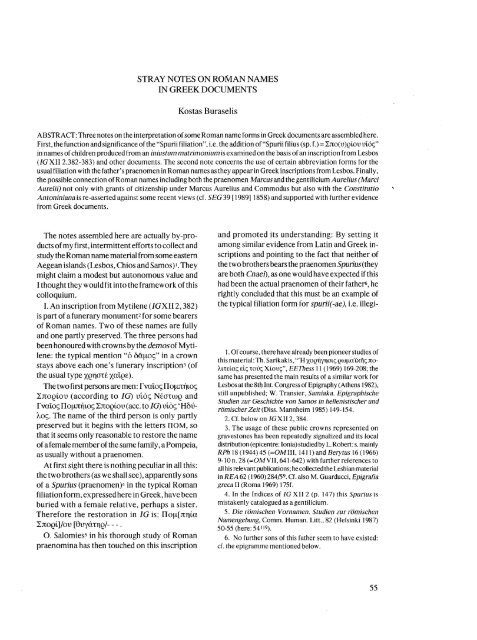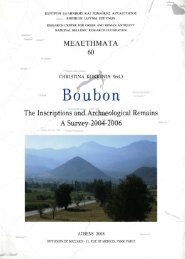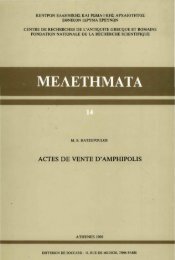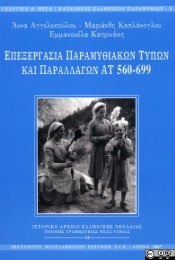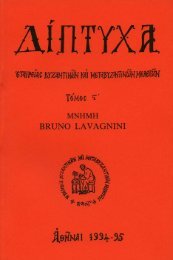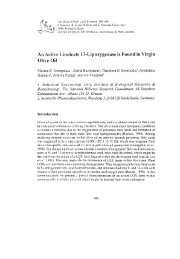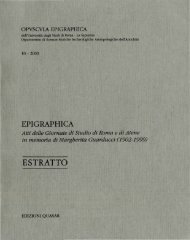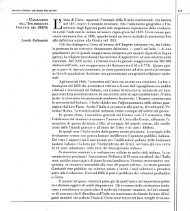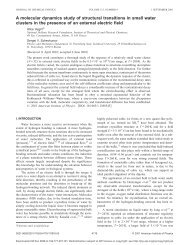Roman onomastics in the Greek East: social and political aspects ...
Roman onomastics in the Greek East: social and political aspects ...
Roman onomastics in the Greek East: social and political aspects ...
Create successful ePaper yourself
Turn your PDF publications into a flip-book with our unique Google optimized e-Paper software.
STRAY NOTES ON ROMAN NAMES<br />
IN GREEK DOCUMENTS<br />
Kostas Buraselis<br />
ABSTRACT: Three notes on <strong>the</strong> <strong>in</strong>terpretation of some <strong>Roman</strong> name forms <strong>in</strong> <strong>Greek</strong> documents are assembled here.<br />
First, <strong>the</strong> function <strong>and</strong> significance of <strong>the</strong> "Spurii filiation", i.e. <strong>the</strong> addition of "Spurii filius (sp. f.) = Σπο(υ)ρίου υίός"<br />
<strong>in</strong> names of children produced from an <strong>in</strong>iustum matrimonium is exam<strong>in</strong>ed on <strong>the</strong> basis of an <strong>in</strong>scription from Lesbos<br />
(IG XII 2.382-383) <strong>and</strong> o<strong>the</strong>r documents. The second note concerns <strong>the</strong> use of certa<strong>in</strong> abbreviation forms for <strong>the</strong><br />
usual filiation with <strong>the</strong> fa<strong>the</strong>r's praenomen <strong>in</strong> <strong>Roman</strong> names as <strong>the</strong>y appear <strong>in</strong> <strong>Greek</strong> <strong>in</strong>scriptions from Lesbos. F<strong>in</strong>ally,<br />
<strong>the</strong> possible connection of <strong>Roman</strong> names <strong>in</strong>clud<strong>in</strong>g both <strong>the</strong> praenomen Marcus <strong>and</strong> <strong>the</strong> gentilicium Aurelius (Marci<br />
Aurelii) not only with grants of citizenship under Marcus Aurelius <strong>and</strong> Commodus but also with <strong>the</strong> Constitutio<br />
Anton<strong>in</strong>iana is re-asserted aga<strong>in</strong>st some recent views (cf. SEG 39 [ 1989] 1858) <strong>and</strong> supported with fur<strong>the</strong>r evidence<br />
from <strong>Greek</strong> documents.<br />
The notes assembled here are actually by-products<br />
of my first, <strong>in</strong>termittent efforts to collect <strong>and</strong><br />
study <strong>the</strong> <strong>Roman</strong> name material from some eastern<br />
Aegean isl<strong>and</strong>s (Lesbos, Chios <strong>and</strong> Samos)·. They<br />
might claim a modest but autonomous value <strong>and</strong><br />
I thought <strong>the</strong>y would fit <strong>in</strong>to <strong>the</strong> framework of this<br />
colloquium.<br />
I. An <strong>in</strong>scription from Mytilene ( JGXII2,382)<br />
is part of a funerary monument 2 for some bearers<br />
of <strong>Roman</strong> names. Two of <strong>the</strong>se names are fully<br />
<strong>and</strong> one partly preserved. The three persons had<br />
been honoured with crowns by <strong>the</strong> demos of Mytilene:<br />
<strong>the</strong> typical mention "ό δάμος" <strong>in</strong> a crown<br />
stays above each one's funerary <strong>in</strong>scription 3 (of<br />
<strong>the</strong> usual type χρηστέ χαίρε).<br />
The two first persons are men : Γναιος Πομπήιος<br />
Σπορίου (accord<strong>in</strong>g to IG) υιός Νέστωρ <strong>and</strong><br />
ΓναΙος Πομπήιος Σπορίου (ace. to IG) υίος ' Ηδύλος.<br />
The name of <strong>the</strong> third person is only partly<br />
preserved but it beg<strong>in</strong>s with <strong>the</strong> letters ΠΟΜ, so<br />
that it seems only reasonable to restore <strong>the</strong> name<br />
of afemale member of <strong>the</strong> same family, aPompeia,<br />
as usually without a praenomen.<br />
At first sight <strong>the</strong>re is noth<strong>in</strong>g peculiar <strong>in</strong> all this:<br />
<strong>the</strong> two bro<strong>the</strong>rs (as we shall see), apparently sons<br />
of a Spurius (praenomen) 4 <strong>in</strong> <strong>the</strong> typical <strong>Roman</strong><br />
filiation form, expressed here <strong>in</strong> <strong>Greek</strong>, have been<br />
buried with a female relative, perhaps a sister.<br />
Therefore <strong>the</strong> restoration <strong>in</strong> IG is: Πομ[πηία<br />
Σπορί]/ου [θυγάτηρ/—.<br />
Ο. Salomies 5 <strong>in</strong> his thorough study of <strong>Roman</strong><br />
praenom<strong>in</strong>a has <strong>the</strong>n touched on this <strong>in</strong>scription<br />
<strong>and</strong> promoted its underst<strong>and</strong><strong>in</strong>g: By sett<strong>in</strong>g it<br />
among similar evidence from Lat<strong>in</strong> <strong>and</strong> <strong>Greek</strong> <strong>in</strong>scriptions<br />
<strong>and</strong> po<strong>in</strong>t<strong>in</strong>g to <strong>the</strong> fact that nei<strong>the</strong>r of<br />
<strong>the</strong> two bro<strong>the</strong>rs bears <strong>the</strong> praenomen Spurius (<strong>the</strong>y<br />
are both Cnaei), as one would have expected if this<br />
had been <strong>the</strong> actual praenomen of <strong>the</strong>ir fa<strong>the</strong>r 6 , he<br />
rightly concluded that this must be an example of<br />
<strong>the</strong> typical filiation form for spurii(-ae), i.e. illegi<br />
1. Of course, <strong>the</strong>re have already been pioneer studies of<br />
this material: Th. Sarikakis, "Ή χορήγησις ρωμαϊκής πολιτείας<br />
εις τους Χίους", EEThess 11 (1969) 169-208; <strong>the</strong><br />
same has presented <strong>the</strong> ma<strong>in</strong> results of a similar work for<br />
Lesbos at <strong>the</strong> 8th Int. Congress of Epigraphy (A<strong>the</strong>ns 1982),<br />
still unpublished; W. Transier, Samiaka. Epigraphische<br />
Studien zur Geschichte von Samos <strong>in</strong> hellenistischer und<br />
römischer Zeit (Diss. Mannheim 1985) 149-154.<br />
2. Cf. below on IGXII2,384.<br />
3. The usage of <strong>the</strong>se public crowns represented on<br />
gravestones has been repeatedly signalized <strong>and</strong> its local<br />
distribution (epicentre: Ionia) studied by L. Robert: s. ma<strong>in</strong>ly<br />
RPh 18 (1944)45 (=OMIII, 1411) <strong>and</strong> Berytus 16 (1966)<br />
9-10 n. 28 (=OMVII, 641-642) with fur<strong>the</strong>r references to<br />
all his relevant publications; he collected <strong>the</strong> Lesbian material<br />
<strong>in</strong> REA 62 ( 1960) 284/5 9 . Cf. also M. Guarducci, Epigrafia<br />
grecali (Roma 1969) 175f.<br />
4. In <strong>the</strong> Indices of IG XII 2 (p. 147) this Spurius is<br />
mistakenly catalogued as a gentilicium.<br />
5. Die römischen Vornamen. Studien zur römischen<br />
Namengebung, Comm. Human. Litt., 82 (Hels<strong>in</strong>ki 1987)<br />
50-55 (here: 54Ί9).<br />
6. No fur<strong>the</strong>r sons of this fa<strong>the</strong>r seem to have existed:<br />
cf. <strong>the</strong> epigramme mentioned below.<br />
55


